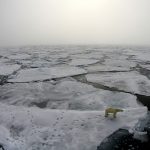 September 8, 2021 4:42 pm
Published by Climate Extremes
September 8, 2021 4:42 pm
Published by Climate Extremes
Predicting how much primary production will further increase in the Arctic Ocean in coming decades depends on the interplay between the increase in light for primary producers, as the sea ice extent and thickness decrease, and the availability of food in the form of nutrients, such as nitrate, phosphate, and silica.
 July 14, 2021 2:23 pm
Published by Climate Extremes
July 14, 2021 2:23 pm
Published by Climate Extremes
This study looks at 6 months of under-ice zooplankton observations from the N-ICE2015 expedition from January to June 2015 in the Eurasian sector of the Arctic Ocean north of Svalbard.
 August 3, 2020 5:05 pm
Published by Climate Extremes
August 3, 2020 5:05 pm
Published by Climate Extremes
Northwest of Svalbard, north of Norway, an area known as Whalers Bay stays ice‐free in winter despite the negative air temperatures. It has been assumed that this open water is maintained by inflow of warm Atlantic Water along Svalbard’s west coast; however, this mechanism has never been demonstrated quantitatively -till now.
 April 7, 2020 2:51 pm
Published by Climate Extremes
April 7, 2020 2:51 pm
Published by Climate Extremes
Research has established a link between Antarctic stratospheric winds and an increased risk of weather conducive to bushfires from late spring to early summer. Further research on the relationship between winds and ozone in the Antarctic stratosphere could improve seasonal forecasts for Australia.
 August 1, 2019 10:00 am
Published by Climate Extremes
August 1, 2019 10:00 am
Published by Climate Extremes
The Climate Variability program has seen an extraordinary amount of activity over the past four months with new arrivals, a clutch of thesis submissions, awards, research voyages and a wealth of research.
 July 20, 2019 2:00 am
Published by Climate Extremes
July 20, 2019 2:00 am
Published by Climate Extremes
In this project, the selected student will develop a numerical algorithm to generate a spatial map of Antarctic ice algal biomass using Machine Learning.
 July 18, 2019 2:00 am
Published by Climate Extremes
July 18, 2019 2:00 am
Published by Climate Extremes
In this project, the selected student will use the satellite-based data obtained from the National Snow and Ice Data Center (NSIDC) to give an overall comparison of the sea ice variations in Arctic and Antarctic during the recent decades.
 July 3, 2019 1:17 pm
Published by Climate Extremes
July 3, 2019 1:17 pm
Published by Climate Extremes
Winter storms over the Arctic leave a legacy that breaks up the ice, melts it from beneath and has led to constant ongoing decline in old ice that far exceeds the period of the storm itself.
 May 29, 2019 2:18 pm
Published by Climate Extremes
May 29, 2019 2:18 pm
Published by Climate Extremes
Using novel ocean glider technology, a team of researchers from France, Norway, and Australia observed small eddy-like lenses of cold water in July 2017 along the western Svalbard shelf in the Arctic.









